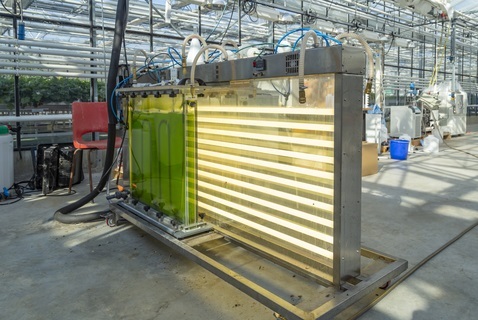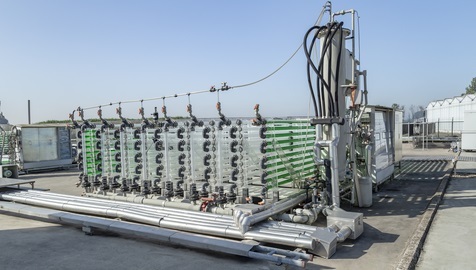
 Data Structure
Data Structure Networking
Networking RDBMS
RDBMS Operating System
Operating System Java
Java MS Excel
MS Excel iOS
iOS HTML
HTML CSS
CSS Android
Android Python
Python C Programming
C Programming C++
C++ C#
C# MongoDB
MongoDB MySQL
MySQL Javascript
Javascript PHP
PHP
- Selected Reading
- UPSC IAS Exams Notes
- Developer's Best Practices
- Questions and Answers
- Effective Resume Writing
- HR Interview Questions
- Computer Glossary
- Who is Who
Photobioreactors: An Overview
Introduction
Photobioreactors (PBRs) are a type of closed system used for growing microalgae or other photosynthetic organisms in a controlled environment. These systems use light as the primary source of energy for the microorganisms, which convert carbon dioxide into organic compounds through the process of photosynthesis.
PBRs are widely used in industries such as biotechnology, biofuels, and wastewater treatment, and they offer several advantages over traditional open-pond systems. Explained below are the working and applications of photobioreactors.
What are Photobioreactors?
Photobioreactors are closed systems used for growing microalgae or other photosynthetic organisms. They are designed to provide optimal conditions for photosynthesis, such as light, temperature, and nutrient availability.
PBRs can range in size from small laboratory-scale systems to large industrial installations.
PBRs are typically made of clear or translucent materials such as glass or plastic to allow light to penetrate into the system. They are also equipped with a range of monitoring and control systems to maintain the ideal conditions for the microorganisms to grow.

How do Photobioreactors Work?
The operation of a photobioreactor can be divided into three main stages: cultivation, harvest, and processing.
Cultivation
During the cultivation stage, microorganisms are introduced into the PBR and allowed to grow. The conditions within the reactor are carefully controlled to optimize the rate of growth and biomass production.
Light is provided using a range of sources, such as LEDs, fluorescent bulbs, or natural sunlight, depending on the design of the system.
Harvest
Once the microorganisms have reached a suitable biomass concentration, they are harvested from the PBR. There are several methods for harvesting microalgae, including sedimentation, centrifugation, and filtration.
Processing
The harvested biomass is then processed into a range of products, depending on the intended use. For example, it may be used for the production of biofuels, animal feed, or pharmaceuticals.

What are the Benefits of Photobioreactors?
Photobioreactors have several advantages for growing microalgae and other photosynthetic organisms.
Increased Productivity
PBRs offer higher productivity than traditional open-pond systems. This is because the closed system allows for greater control over the growth conditions, such as light intensity and nutrient availability. This leads to faster growth rates and higher biomass yields.
Higher Quality Biomass
The controlled environment of a PBR allows for the production of high-quality biomass. The microorganisms are grown under optimal conditions, which leads to a higher concentration of desirable compounds such as proteins, lipids, and pigments.
Reduced Contamination
PBRs are less prone to contamination than open-pond systems. This is because the closed system provides a physical barrier between the microorganisms and the external environment, reducing the risk of contamination from pathogens and other unwanted organisms.
Reduced Land and Water Use
PBRs require significantly less land and water than traditional open-pond systems. This is because they can be stacked vertically, allowing for higher biomass yields per unit area of land. They also use a closed-loop water system, which reduces the amount of water required for cultivation.
Versatility
PBRs can be used to grow a wide range of microorganisms, including algae, bacteria, and cyanobacteria. This makes them a versatile tool for a range of applications, from biofuel production to wastewater treatment.
Sustainable Production
PBRs offer a sustainable method of production for a range of products. They use renewable energy sources such as solar power to provide light for photosynthesis. They also use carbon dioxide from industrial processes, which reduces greenhouse gas emissions and helps to mitigate climate change.
Scalability
PBRs can be scaled up or down depending on the production requirements. This makes them suitable for both laboratory-scale research and large-scale industrial production.
Consistent Quality
The controlled environment of a PBR allows for the production of consistent quality biomass. This is important for industries such as pharmaceuticals, where the quality of the product is critical.
Reduced Labour Costs
PBRs require less labor than traditional open-pond systems. This is because they can be automated to a greater extent, reducing the need for manual labor.
Reduced Capital Costs
PBRs offer a cost-effective method of production compared to traditional open-pond systems. While the initial capital costs may be higher, the increased productivity and higher-quality biomass produced by PBRs can result in a faster return on investment.
Applications of Photobioreactors
Photobioreactors have a range of applications across several industries, including biotechnology, biofuels, wastewater treatment, and food production.
Biotechnology
PBRs are used in the production of a range of biotechnological products, such as enzymes, pigments, and bioactive compounds. These products have a range of applications in industries such as food, cosmetics, and pharmaceuticals.
Biofuels
PBRs are used in the production of biofuels such as biodiesel and bioethanol. Microalgae are an attractive feedstock for biofuel production because they have a high lipid content and can be grown on non-arable land.
Wastewater Treatment
PBRs can be used in the treatment of wastewater, where microorganisms are used to remove nutrients such as nitrogen and phosphorus from the water. This process, known as microalgal-based wastewater treatment, has several advantages over traditional wastewater treatment methods, including lower energy and chemical requirements.
Food Production
PBRs can be used in the production of food products such as spirulina, a type of blue-green algae that is high in protein and vitamins. Spirulina is commonly used as a dietary supplement and has the potential as a food source for human consumption.
Carbon Capture
PBRs can be used to capture carbon dioxide from industrial processes, such as power plants or cement factories. The captured carbon dioxide can then be used to support the growth of microorganisms, which can be used for a range of applications, including biofuel production.
Challenges and Future Directions
Despite the many advantages of photobioreactors, there are still several challenges that must be addressed to maximize their potential.
Cost
The initial capital costs of PBRs can be high, and the cost of operation can also be significant. Improvements in technology and process optimization are required to reduce these costs.
Scale-up
The scalability of PBRs is still an issue. While PBRs have been successfully scaled up to industrial sizes, there is still a need for improved methods for large-scale cultivation.
Efficiency
While PBRs offer higher productivity than traditional open-pond systems, there is still room for improvement. Advances in lighting technology and nutrient delivery systems are required to optimize growth conditions and improve productivity.
Productivity
While PBRs offer high productivity, the biomass produced is often of low value. Research is needed to identify new applications for microalgal biomass that can increase its value and create new markets.
Conclusion
Overall photobioreactors are closed systems that provide optimal conditions and thus enable the growth of microalgae and other photosynthetic forms. They promote culturing processing and harvesting these forms to be further used in the fields of biotechnology, as biofuels, for carbon capture etc.

